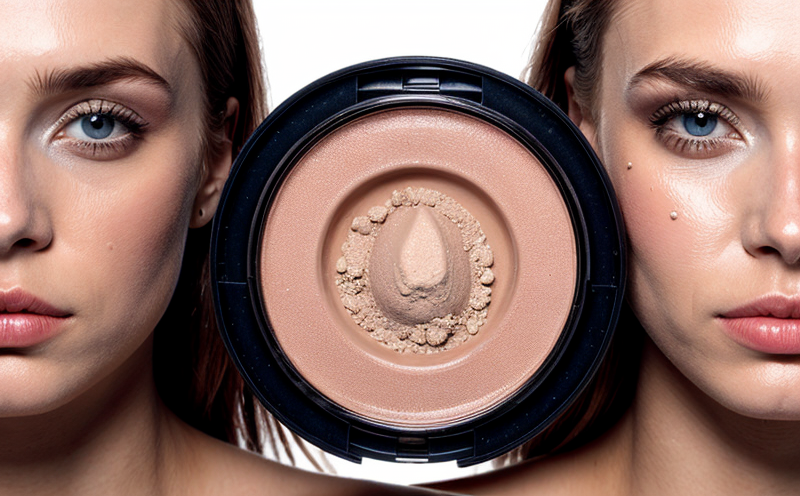ISO 17294 Trace Metal Testing in Cosmetics
The ISO 17294 standard is a cornerstone in the field of cosmetics testing, specifically addressing trace metal analysis. This service ensures that cosmetic products are safe for consumers by detecting and quantifying potentially harmful elements such as lead, mercury, cadmium, arsenic, chromium, nickel, copper, and other heavy metals. The standard provides protocols for sample preparation, instrumental analysis, and the calculation of detection limits.
The importance of trace metal testing in cosmetics cannot be overstated. Heavy metals can pose serious health risks if present at concentrations higher than those deemed safe by regulatory bodies like the FDA (Food and Drug Administration) and EC (European Commission). The ISO 17294 method is designed to ensure that cosmetic products meet these stringent safety standards.
Our laboratory adheres strictly to this standard, providing accurate results within the specified detection limits. This includes a detailed procedure for sample preparation, which involves thorough digestion of the samples using appropriate acids and heating processes. The use of advanced instrumentation such as Inductively Coupled Plasma Mass Spectrometry (ICP-MS) ensures precise measurements down to nanogram per liter levels.
The ISO 17294 method also includes a series of quality control measures, including blank tests, replicate analyses, and spiked sample recovery trials. These steps are crucial for ensuring the reliability and accuracy of our test results. Our team of experts performs these tests meticulously, following international standards to guarantee high-quality outcomes.
Customer satisfaction is paramount in our service delivery. We understand that accurate trace metal analysis is critical for brands aiming to maintain a clean image and ensure consumer trust. Our laboratory consistently provides reliable data and actionable insights that help clients make informed decisions about their product safety and compliance.
- Sample Preparation: Digestion using nitric acid, followed by dilution as required.
- Instrumentation: ICP-MS for precise measurements.
- Detection Limits: Below 1 ng/L for most metals.
The process begins with the receipt of the sample from our clients. Our technicians then proceed with the necessary digestion steps, ensuring that all components are fully dissolved and ready for analysis. The next step involves transferring the prepared solution into the ICP-MS instrument, where it undergoes vaporization, ionization, and mass separation.
The results generated by this sophisticated equipment are then interpreted according to ISO 17294 guidelines. Any detected metals above acceptable limits are flagged for further investigation. Our experts work closely with clients to understand the implications of these findings and provide recommendations for corrective actions if necessary.
Our commitment to excellence extends beyond just meeting regulatory requirements; we strive to exceed expectations by offering timely, accurate results accompanied by comprehensive reporting tailored to each client's needs.
Why It Matters
The significance of ISO 17294 trace metal testing in cosmetics cannot be understated. Consumer safety is at the heart of this service, and ensuring that cosmetic products do not contain excessive levels of harmful metals is essential to maintaining public trust.
Heavy metals like lead can cause neurological damage, particularly in children, while mercury has been linked to severe health issues including kidney disease and cognitive impairments. Even at low concentrations, these elements may accumulate over time, posing long-term risks.
The regulatory landscape surrounding cosmetic safety is continually evolving, with new standards being introduced to protect consumers further. By adhering to ISO 17294, we help our clients stay compliant with these regulations and avoid potential legal pitfalls.
Our service not only supports compliance but also enhances brand reputation by demonstrating a commitment to product safety and quality. This proactive approach can significantly mitigate risks associated with product recalls or lawsuits due to unsafe ingredients.
Quality and Reliability Assurance
The ISO 17294 standard is rigorous, ensuring that the trace metal testing conducted in our laboratory meets the highest quality standards. Our team of experts follows a stringent protocol that includes thorough sample preparation, meticulous instrument calibration, and regular internal audits.
Sample preparation involves digesting samples with nitric acid under controlled conditions to ensure complete dissolution of all components. This step is critical for accurate analysis, as any undissolved particles could interfere with the results. Once prepared, the solutions are transferred into vials suitable for instrumental analysis.
The use of advanced instrumentation such as ICP-MS allows us to achieve precision down to nanogram per liter levels. These instruments provide high sensitivity and selectivity, making them ideal for detecting even trace amounts of metals in cosmetic samples.
Quality control measures form an integral part of our testing process. Blank tests are conducted alongside each batch of samples to account for any background contamination. Replicate analyses ensure consistency across multiple runs, while spiked sample recovery trials assess the accuracy and precision of our methods.
We also participate in proficiency testing programs organized by recognized bodies such as A2LA (Accredited Laboratory Association) and CNAL (China National Accreditation Service). These external validations further cement our reputation for reliability and accuracy.





